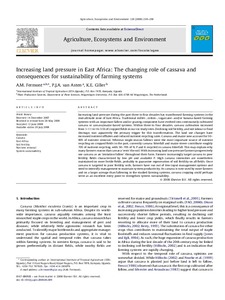| dc.contributor.author | Fermont, A.V. |
| dc.contributor.author | Asten, Piet J.A. van |
| dc.contributor.author | Giller, Ken E. |
| dc.date.accessioned | 2019-12-04T11:14:53Z |
| dc.date.available | 2019-12-04T11:14:53Z |
| dc.date.issued | 2008 |
| dc.identifier.citation | Fermont, A.V., Van Asten, P.J.A. & Giller, K.E. (2008). Increasing land pressure in East Africa: the changing role of cassava and consequences for sustainability of farming systems. Agriculture, Ecosystems & Environment, 128(4), 239-250. |
| dc.identifier.issn | 0167-8809 |
| dc.identifier.uri | https://hdl.handle.net/20.500.12478/2873 |
| dc.description | Published online: 29 July 2008 |
| dc.description.abstract | Increasing land pressure during the past three to four decades has transformed farming systems in the
mid-altitude zone of East Africa. Traditional millet-, cotton-, sugarcane- and/or banana-based farming
systems with an important fallow and/or grazing component have evolved into continuously cultivated
cassava or cassava/maize-based systems. Within three to four decades, cassava cultivation increased
from 1–11 to 16–55% of cropped fields in our six study sites. Declining soil fertility, and not labour or food
shortage, was apparently the primary trigger for this transformation. The land use changes have
increased nutrient offtakes and reduced nutrient recycling rates. Cassava and maize now account for 50–
90% of nutrient removal. Whereas single-season fallows were the most important source of nutrient
recycling on cropped fields in the past, currently cassava litterfall and maize stover contribute roughly
70% of nutrient recycling, with 50–70% of N, P and K recycled in cassava litterfall. This may explain why
many farmers reason that cassava ‘rests’ the soil. With increasing land use pressure farmers progressively
use cassava as an ‘imitation fallow’ throughout their farm. Farmers increasingly target cassava to poor
fertility fields characterized by low pH and available P. High cassava intensities are nonetheless
maintained on more fertile fields, probably to guarantee regeneration of soil fertility on all fields. Once
cassava is targeted to poor fertility soils, farmers have run out of low-input management options and
need to intensifymanagement tomaintain system productivity. As cassava is now used by more farmers
and on a larger acreage than fallowing in the studied farming systems, cassava cropping could perhaps
serve as an excellent entry point to strengthen system sustainability. |
| dc.description.sponsorship | Directorate-General for International Cooperation, the Netherlands |
| dc.language.iso | en |
| dc.subject | Farming Systems |
| dc.subject | Soil Fertility |
| dc.subject | Cassava |
| dc.subject | Nutrient Removal |
| dc.subject | System Sustainability |
| dc.title | Increasing land pressure in East Africa: the changing role of cassava and consequences for sustainability of farming systems |
| dc.type | Journal Article |
| dc.description.version | Peer Review |
| cg.contributor.affiliation | International Institute of Tropical Agriculture |
| cg.contributor.affiliation | Wageningen University and Research Centre |
| cg.coverage.region | Africa |
| cg.coverage.region | Acp |
| cg.coverage.region | East Africa |
| cg.coverage.region | Europe |
| cg.coverage.country | Uganda |
| cg.coverage.country | Netherlands |
| cg.isijournal | ISI Journal |
| cg.authorship.types | CGIAR and advanced research institute |
| cg.iitasubject | Cassava |
| cg.iitasubject | Plant Production |
| cg.iitasubject | Farming Systems |
| cg.iitasubject | Food Security |
| cg.iitasubject | Farm Management |
| cg.iitasubject | Soil Fertility |
| cg.iitasubject | Plant Diseases |
| cg.iitasubject | Soil Information |
| cg.iitasubject | Plant Health |
| cg.iitasubject | Disease Control |
| cg.iitasubject | Genetic Improvement |
| cg.iitasubject | Pests Of Plants |
| cg.iitasubject | Plant Breeding |
| cg.iitasubject | Plant Genetic Resources |
| cg.accessibilitystatus | Limited Access |
| local.dspaceid | 93974 |
| cg.identifier.doi | https://dx.doi.org/10.1016/j.agee.2008.06.009 |

